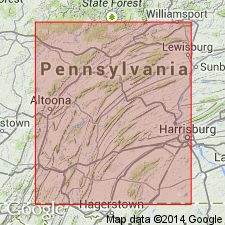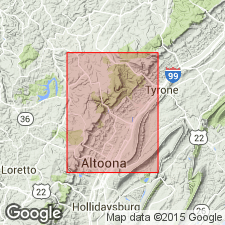
- Usage in publication:
-
- Hatter formation
- Modifications:
-
- Named
- Dominant lithology:
-
- Limestone
- AAPG geologic province:
-
- Appalachian basin
Summary:
Named for Hatter Creek, north of Roaring Spring, Blair Co., PA. Consists of a lower granular limestone (Eyer member), a middle dark dense argillaceous limestone (Grazier member), and an upper siliceous limestone (Hostler member). Thickness 70-110 feet. Overlies Loysburg formation; underlies Benner limestone. Publication contains stratigraphic column.
Source: GNU records (USGS DDS-6; Reston GNULEX).

- Usage in publication:
-
- Hatter Formation
- Modifications:
-
- Overview
- AAPG geologic province:
-
- Appalachian basin
Summary:
The Hatter Formation has been recognized throughout the Valley and Ridge province in central PA, but changes character in the extreme northeast. According to Wagner (1966), it extends in the subsurface to WV. Unit consists of a basal fossiliferous limestone, overlain by fine-grained limestone containing shaly partings, which in turn is overlain by fucoidal, fossiliferous magnesian limestone. The basal Eyer Member is composed of fossiliferous, medium- to thick-bedded calcarenites interbedded with medium-bedded calcilutites and thin, irregular shaly partings. The middle Grazier Member consists of medium-dark-gray, medium- to thick-bedded calcisiltite and calcilutite. Upper Hostler Member is coarser grained than the Grazier, consisting mostly of calcisiltite and thin interbeds of calcarenite. Hatter conformably overlies the Loysburg Formation. Contact is placed at the base of the first fossiliferous calcarenite of the Eyer Member. Upper contact with the Snyder Formation is placed at the oolite beds that mark the base of the Snyder. Thickness measured along PA Rte 453 west of Pemberton is 30+/-2 m. The Eyer Member is 3.4+/-0.4 m, the Grazier Member is 14.6+/-2 m, and the Hostler Member is 12+/-2 m thick. Best exposure of the unit is along the east side of PA Rte 453, approximately 10 m north of the first culvert drain from the north end of the roadcut, west of Pemberton, 7 km east of the northeast corner of the Bellwood quad. No basis given for Late Ordovician age assignment. [No mention of Black River Group.]
Source: GNU records (USGS DDS-6; Reston GNULEX).
For more information, please contact Nancy Stamm, Geologic Names Committee Secretary.
Asterisk (*) indicates published by U.S. Geological Survey authors.
"No current usage" (†) implies that a name has been abandoned or has fallen into disuse. Former usage and, if known, replacement name given in parentheses ( ).
Slash (/) indicates name conflicts with nomenclatural guidelines (CSN, 1933; ACSN, 1961, 1970; NACSN, 1983, 2005, 2021). May be explained within brackets ([ ]).

